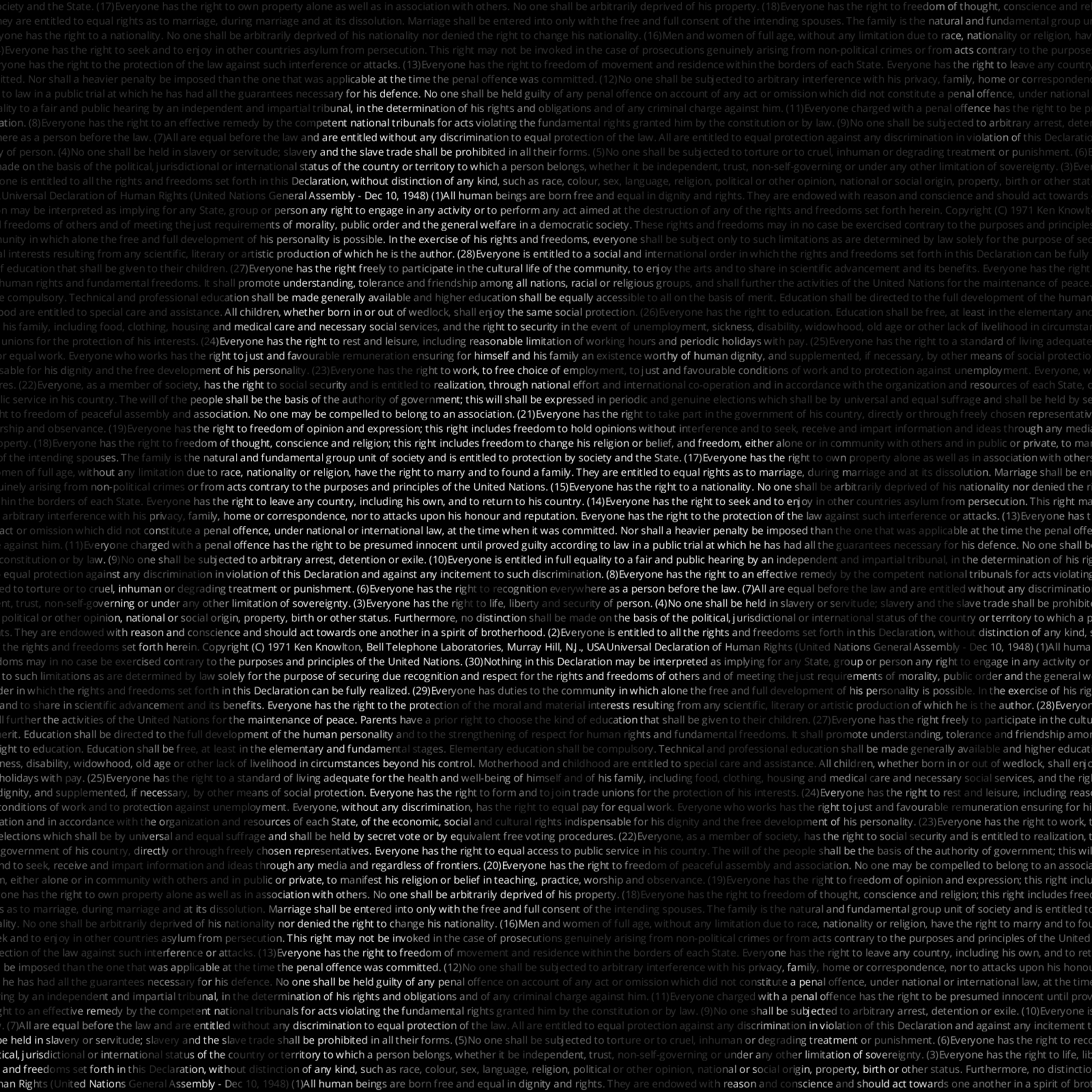Kenneth Knowlton’s “Universal Declaration of Human Rights”

import Diagrams.Backend.SVG.CmdLineWe recreate the “Universal Declaration of Human Rights” by Kenneth Knowlton. The picture is taken from here.
{-# LANGUAGE NoMonomorphismRestriction #-}
import Codec.Picture
import Codec.Picture.Types
import Data.Colour.CIE
import Data.List.Split
import qualified Data.Text as T
import qualified Data.Text.IO as TIO
import Diagrams.Prelude
import Diagrams.Backend.Rasterific.CmdLineThe idea is to split the Declaration into a set of lines and apply to each line a gradient corresponding to the picture.
First, we load an image using JuicyPixels. More precisely, we extract a list of
colors. For convenience, we use a custom datatype containing the height, width
and the list of colours. To be consistent with diagrams, colors are stored as
Colour.
data ColourImage b = ColourImage { cColors :: [Colour b]
, cHeight :: Int
, cWidth :: Int
}Then we load the image using JuicyPixels, knowing the image is in YcbCr8 format
(not quite portable…). Each pixel is converted to a Colour.
getColors :: (Ord b, Floating b) => FilePath -> IO (Maybe (ColourImage b))
getColors fp = do
image <- readImage fp
case image of
Left _ -> return Nothing
Right image' -> return (getColors' image')
getColors' :: (Ord b, Floating b) => DynamicImage -> Maybe (ColourImage b)
getColors' (ImageYCbCr8 image@(Image w h _)) =
Just (ColourImage colors h w)
where colors = pixelFold (\acc i j pix -> (ycbcrToRGB pix) : acc) [] image
getColors' _ = Nothing
ycbcrToRGB :: (Ord b, Floating b) => PixelYCbCr8 -> Colour b
ycbcrToRGB pix = sRGB24 r g b
where (PixelRGB8 r g b ) = convertPixel pix :: PixelRGB8Now we have the colors, we need the text. Knowing the width and height of the picture, we generate a set of lines with constant width from the Declaration:
-- We want as many lines as there are pixels lines
content :: Int -> Int -> IO [T.Text]
content w h = do
text1 <- TIO.readFile "doc/static/Universal Declaration of Human Rights.txt"
-- At most h repeat as we cannot have "cycle" for Text
return $ take h $ T.chunksOf w $ T.replicate h text1Next, we create the gradient. All colors will be split into constant-width “lines” of color. For each line, we create a gradient.
stops :: Fractional d => [Colour Double] -> d -> [GradientStop d]
stops colors w = mkStops stops'
where
n = length colors-1
stops' = map createStop [0..n]
dx = 1 / fromIntegral n
createStop i = (colors !! i, fromIntegral i * dx, 1)
gradient colors w =
mkLinearGradient (stops colors w) ((-frac*w) ^& 0) ((frac*w) ^& 0) GradPad
where frac = 0.7
-- The fraction show only parts of the image hereWe can now create the line from the text and apply the gradient:
createText :: T.Text -> Diagram B
createText s = text (T.unpack s) # fontSize (local 8)
createLine :: Int -> Int -> ([Colour Double], T.Text) -> Diagram B
createLine w h (colors, s) =
(createText s # fillTexture (gradient colors w')) `atop` rect w' h' # fc black
where (w', h') = (fromIntegral w, fromIntegral h)The final function will load the list of colors and create lines according to the procedure above. As some parts of the picture are pitch black, we still want to see the text, so we define a minimum luminance:
minLuminance :: (Ord b, Floating b) => Colour b -> Colour b
minLuminance c
| (luminance c) < 0.032 = sRGB24 50 50 50
| otherwise = c
example :: IO (Diagram B )
example = do
Just img <- getColors "doc/static/girl_gaze_contrast1_small2.jpg"
let colors' = map minLuminance $ cColors img
let (h, w) = (cHeight img, cWidth img)
let heightRect = 15
let width = heightRect*h
let colors = chunksOf w colors'
lines <- content 280 h
-- We need a rectangle for each line
let all = map (createLine width heightRect) $ zip colors lines :: [Diagram B]
return $ cat (r2 (0, 1)) allmain = mainWith (example :: Diagram B)